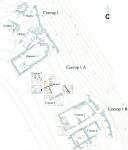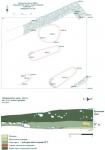Summary (English)
SHISHMANOVO KALE FORTRESS (Veselin Hadzhiangelov – vhajiangelov@yahoo.com) The explorations were carried out in Sector 1 in the northern part of the site where the main fortification gate and Church No. 1 were situated, and in Sector 1A located to the south. Two occupation periods were documented: the second half of the 3rd – beginning of the 4th centuries AD and the second half of the 4th – beginning of the 5th centuries AD. Buildings Nos. 6 and 7 in Sector 1A belonged to the first occupation period. Building No. 6 was built of wattle-and-daub, with a roof covered with tegulae. A number of empty pits that accommodated dolia were discovered. A coin of Constantius II minted in AD 341 – 346, found in the layer over the debris, was terminus ante quem for the destruction of the building. A pile of burned fragmentary wattle-and-daub, fragmentary tegulae, sherds and terracotta loom weights, belonging to Building No. 7, was discovered. Judging from the finds, including a coin of Caracalla, the house dated to the 3rd century AD. It was destroyed in the beginning of the 4th century AD, judging from a coin of Licinius I. Buildings Nos. 4 and 5 and the fortification belonged to the second occupation period. Building No. 4 was situated in Sector 1, at the inner gate of the eastern fortification wall. The gate consisted of two parallel L-like side walls, 80 cm wide and situated at 3.87 m from each other. Building No. 4 was built of roughly-cut stones bonded with clay, with a roof covered with tegulae. A coin of Constantine the Great minted in AD 330 – 335 was found on the floor; it was terminus post quem for the construction of the building. Building No. 5 was situated in Sector 1A. Its walls were 60 cm wide, built of roughly-cut stones and boulders bonded with clay. The building was constructed c. AD 350, judging from coins of Constantius II minted in AD 341 – 346. It was destroyed at the end of the 4th century AD, judging from coins of Theodosius I and Arcadius. After the buildings were destroyed at the end of the 4th century AD, a Christian cemetery appeared in that area. Five burials were explored and thus, their total number reached nine.
- Veselin Hadzhiangelov - Museum of History – Samokov
Director
Team
Research Body
- Museum of History – Samokov






![Download [PDF]](/excavation/skins/fasti/images/results/download_sml.png)

